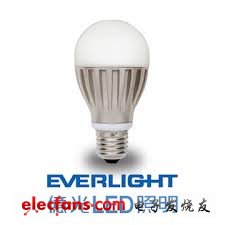Everlight LED opens up another way to penetrate agriculture and fisheries
![]() Everlight is striving to expand the penetration rate of light emitting diodes (LEDs) in the agricultural and fishery markets. The cost of LED bulbs has fallen sharply and the market competition is fierce, which has led to shrinking profitable space for LED packaging plants. Therefore, Everlight ’s operating tentacles are actively expanding into emerging agricultural and fishery application fields such as plant lights and fish collection lights. Great revenue contribution.
Everlight is striving to expand the penetration rate of light emitting diodes (LEDs) in the agricultural and fishery markets. The cost of LED bulbs has fallen sharply and the market competition is fierce, which has led to shrinking profitable space for LED packaging plants. Therefore, Everlight ’s operating tentacles are actively expanding into emerging agricultural and fishery application fields such as plant lights and fish collection lights. Great revenue contribution.
Ye Yinfu, chairman of Everlight Electronics, said that the serious oversupply of LED chips in 2012 caused the rapid decline in average sales price (ASP) and the decline in gross profit. In addition, the price of LED bulbs is rapidly decreasing, which will lead to shrinking profits of LED packaging factories. Will actively expand the market share of emerging applications other than commercial, home and street lights, such as plant lights, fish lamp and other agricultural lighting.

Ye Yinfu pointed out that LED plant factories have many advantages such as high-density planting, stable production, low energy consumption and environmental pollution, urban production can reduce transportation, and greening the city. In the future, agriculture will move from outdoor to indoor and become a new urban landscape.
As for fish-collecting lamps, traditional fish-collecting lamps use tungsten filament lamps, metal-clad lamps and high-pressure mercury lamps. The temperature of the lamps is high and the glass structure is not resistant to impact, which is prone to safety concerns. Ye Yinfu mentioned that traditional fish-collecting lamps consume electricity With a volume of 2,000 to 4,000 watts (W), the luminous efficiency of the lamp is only 50 lumens per watt; the power consumption of the LED fish lamp is 50 to 300 watts, and the luminous efficiency of the lamp is 90 lumens per watt.
Not only that, the traditional fish-collecting lamp is divergent and has a wide light irradiation range, but only about 30% of the light energy is irradiated to the sea surface, so it is necessary to increase the power consumption to increase its light penetration rate; relatively speaking, the LED lamp The light source of the fish lamp is directional, and can improve the illumination range and the penetration of underwater illumination through a specific optical design. In addition, the traditional fish-collecting lamp has a fixed spectrum and contains ultraviolet light, and the life span is only 6-14 months, and the warming lamp takes 20-30 minutes; the LED fish-collecting lamp light source can adjust the light spectrum according to the preferences of different fish schools. , And the light can be instantly extinguished.
Ye Yinfu believes that even if the price of home LED bulbs reaches the sweet price of 10 US dollars, it is still higher than the price of energy-saving fluorescent lamps (CFL) 3 to 5 US dollars. Continued price reduction, and this will reduce the gross profit of LED. Therefore, LED manufacturers still have to work hard to develop new blue oceans for other LED lighting applications to improve product profitability.
USB3.0 - also considered SuperSpeed USB - for those with PC or audio / high-frequency device to provide a variety of devices connected to a standard interface. From the keyboard to high-throughput disk drive, a variety of devices can use this low-cost interface for smooth operation of the plug and play connectivity, users basically do not spend too much thought in it. The new USB 3.0 to maintain compatibility with USB 2.0 also provides several enhancements to the following:
Greatly increased bandwidth - up to 5Gbps full duplex (USB2.0 was 480Mpbs duplex) to achieve better power management enables the host to provide more power for the device to achieve USB-rechargeable battery, LED lighting And mini-fan applications. Enable faster identification of the host device the new agreement makes data processing more efficient USB 3.0 storage device can be limited by the rate of transferring large amounts of stored files (such as HD movies).
For example, a use of USB 3.0 flash drive in the 3.3 seconds to transfer 1GB of data to a host, and USB 2.0 requires 33 seconds. Consumer electronics devices by increasing the resolution and storage performance requirements driven by the hope that through a broadband Internet connection to achieve wider media applications, so users need faster transmission performance, to simplify the downloading, storage, and a large number of multimedia Content sharing. USB 3.0 to provide consumers with easy connectivity it needs played a crucial role. When the device when used in consumer, USB 3.0 will address not recognize USB2.0 devices without battery problems. Host to reduce the current through the USB 3.0 slow to recognize these devices, such as mobile phone battery has gone bad.
For the purposes of systems and ASIC developers, USB 3.0 chips and IP to ensure a wide range of practical requirements of each design can be met in a timely manner. The full range of support for standards such as USB 3.0 is particularly important because the speed, advanced protocol and a variety of cable length (from a few inches to several meters) makes the design and standards compliance as a challenge.
USB 3.0 Flash Drive,Type-C USB Stick,3.0 USB Flash Drive,3.0 Pen Drive
Custom Usb Gift company limited , https://www.customusbgift.com
